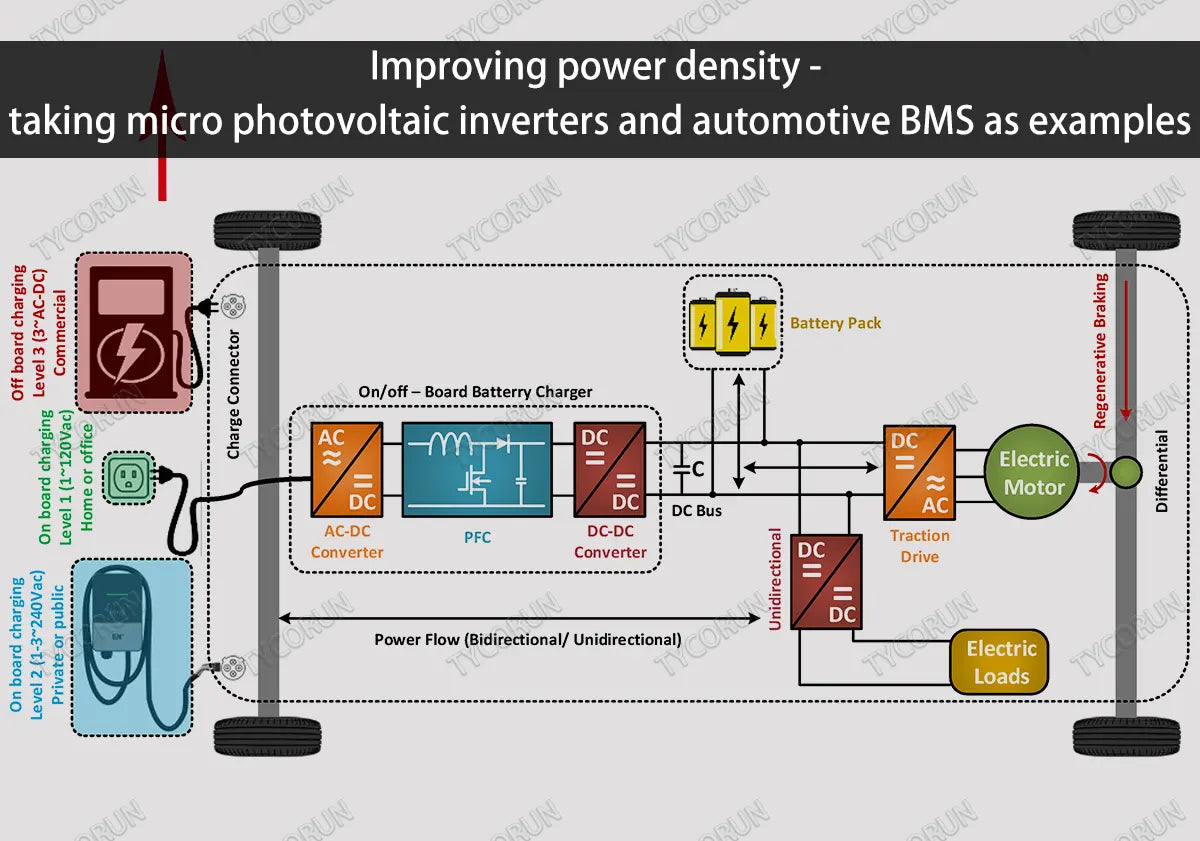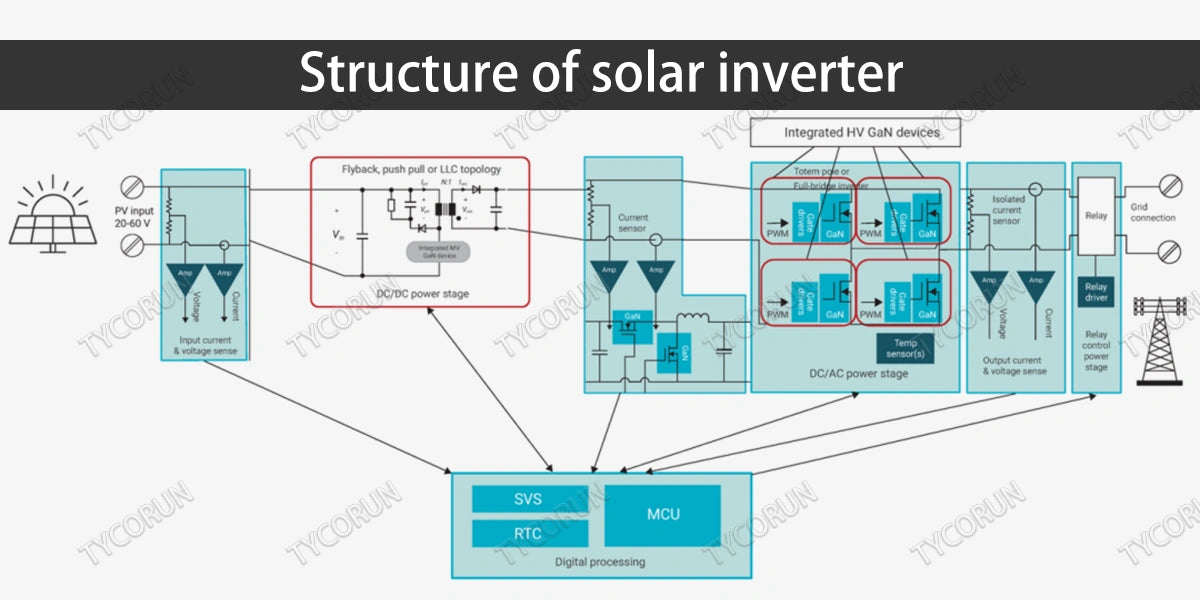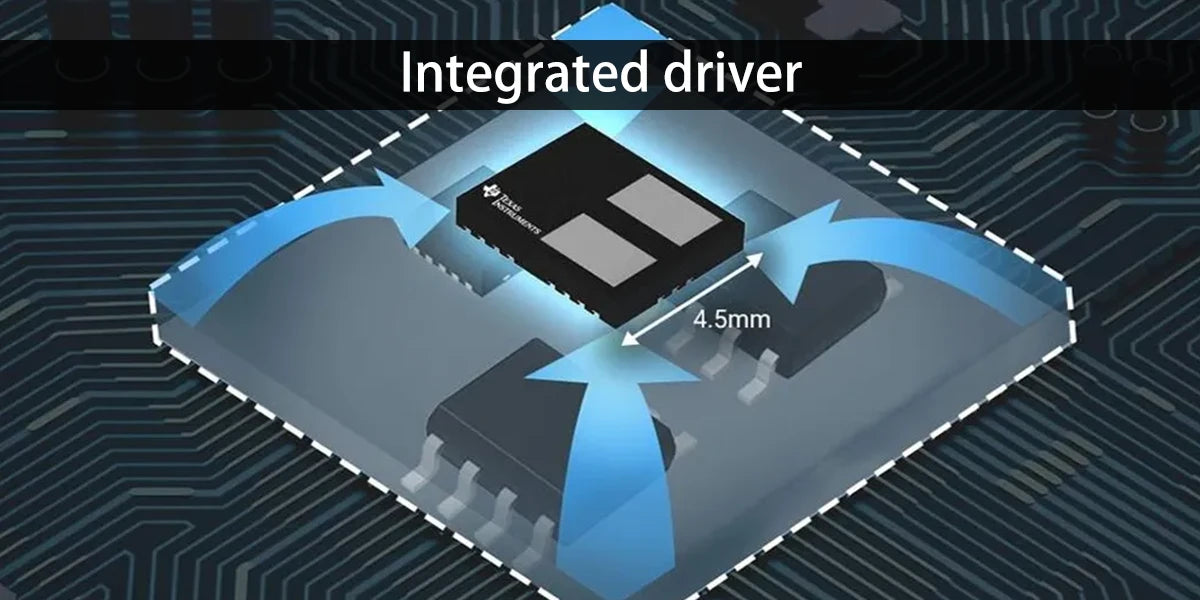
Power density is very important in power supply design, especially in space-constrained applications. A typical example is a micro solar inverter such as 500w inverter or 1000w inverter. In order to optimize the output efficiency of the solar panel, an MPPT (Maximum Power Point Tracking) controller is usually installed on the back of it to fully utilize the energy of the solar panel. Considering the limited installation volume and size, MPPT usually has high power density requirements.
Automotive battery management system (BMS) also have high requirements for power density. Electric vehicle space constraints require power modules to provide sufficient power output in a smaller volume or package size to meet fast charging and high-current discharge. In addition, vehicles pursue lightweighting. Designed to improve energy efficiency, the power management chips and power devices used in BMS also need to reduce weight while ensuring functionality, which also relies on increasing power density.
Through this article, let’s look at the ways to improve power density from the use cases of micro solar inverters and BMS.
Main content:
1. Micro solar inverter
If the micro solar inverter is designed with silicon, the efficiency will be about 94-96%; if GaN is used, the efficiency of the whole machine can be qualitatively improved due to the reduction of switching losses. Dr. Yang Fei, head of Texas Instruments' gallium nitride product business, said that according to Texas Instruments' reference design based on gallium nitride (GaN), it can achieve an efficiency of more than 98%, thus bringing more economical benefits to home solar power system or energy storage systems.

After using gallium nitride components, the frequency can be increased, the system volume can be reduced, and the system power density can be greatly improved. There are many advantages brought by increased power density.
- Smaller size can meet customers’ industrial needs;
- The overall cost of the system can be optimized, because when the size is smaller, the system installation and packaging costs will be reduced.
From the perspective of power supply settings, when the frequency increases, the size of passive components including output capacitors, inductors, etc., will decrease. After these components are reduced, the BOM of the system will also be reduced. New gallium nitride products integrate driver and GaN, so there are very few peripheral circuits required.
Therefore, whether it is from the system or peripheral circuits, from the whole or part of it, the new products can help you reduce the costs, improve system efficiency, and increase the power density.
① Integrated driver
Dr. Yang Fei said that whether it is 100V GaN or high-voltage side GaN, integrating gallium nitride and driver is the trend of future gallium nitride products. As a third-generation semiconductor, gallium nitride has lower switching losses than traditional silicon devices. Texas Instruments has also leveraged this advantage into the new generation of 100V GaN, including the half-bridge module LMG2100R044 and single-tube GaN plus driver Integrated LMG3100R017.

By integrating the driver and gallium nitride together, the power supply design frequency can be pushed up. After the frequency is pushed up, the power system design requirements, including the size of the inductor, transformer and busbar capacitor, can be reduced accordingly, and the size of the printed circuit board can be reduced by 40%. At the same time, by increasing the switching frequency, the number of passive components in the entire power supply can be reduced accordingly, and the power density can reach more than 1.5kW per cubic inch.
In addition, such a design has better consistency for GaN performance, because inverter manufacturers will optimize internal parameters and drive circuits while bringing more features. On the contrary, if the user specially designs the driving circuit during use, it will be easily affected by the integration parameters, resulting in the inability to fully utilize the performance of the entire GaN and limiting the actual user experience.
With the integrated design, users don’t have to worry about layout issues and can just send the signal directly. Through power conversion through GaN integrated driver products, the entire design will be pretty much simplified.
② Unique packaging improves system heat dissipation
While improving power density, system heat dissipation must also be considered. Chips are becoming smaller and smaller, but their power is getting larger and larger, making heat dissipation a challenge. For system heat dissipation, LMG2100R044 and LMG3100R017 adopt a unique packaging design, have a unique heat dissipation system, and use double-sided heat dissipation.
The top and back layers can dissipate heat and reduce the size. The new device can dissipate heat from the top layer, and there is also a large QFN heat sink on the back, which can dissipate heat from the bottom PCB.
In other words, taking into account the demand for high power density, the entire heat dissipation has been further improved, and the heat dissipation performance of the system has been optimized from a packaging perspective to help customers improve the high power density of the overall power supply design.
2. Automotive battery management system BMS
As the world moves toward vehicle electrification, powertrain and BMS designers look for new ways to increase system-level power density and efficiency. In the past, isolated auxiliary power solutions often used heavy, bulky and vibration-sensitive transformers, which complicated the design layout and resulted in high radiated EMI.

① Integrated transformer
To significantly reduce the height and size of isolated DC/DC, the isolated power transformer, primary-side and secondary-side bridges and control logic are integrated into a single package, so designers do not need to use the components that are bulky, large and easily affected by vibration, thereby improving the reliability, simplifying design and enhancing vibration resistance.
UCC33420-Q1 features an EMI-optimized transformer that allows designers to easily meet the most stringent EMI requirements, such as CISPR 32 and CISPR25 Class 5 compliance standards, while reducing component count and simplifying filter design.
Designers can implement a robust solution that is robust to noise, with industry-highest common-mode transient immunity (CMTI) of greater than 200V/ns and primary-to-secondary capacitance of less than 3pF, allowing it to withstand extremely high voltage transient. UCC33420 is the second generation of isolated power supply. Compared with the previous generation, UCC33420 has increased the switching frequency by more than three times and optimized the transformer design, which can further reduce the costs.

② Use soft switching to reduce noise
The DC/DC module mentioned above ensures the same level of efficiency at 3 times the switching frequency. To this end, the product adopts unique performance control and makes special treatments for EMI penetration at faster switching speeds. There is no need to add peripherals, including EMI filters; in addition, the high switching frequency can greatly reduce the ripple noise.
Summary
Applications such as solar power systems, automobiles, and data centers have put forward higher requirements for the power density of power supplies. Judging from the solutions mentioned in this article, there are several ways to increase power density.
Using wide-bandgap semiconductor materials such as gallium nitride and leveraging their higher breakdown field strength, thermal conductivity, and electron mobility can increase switching speed and efficiency, reduce the losses, and thereby increase the power density.
In addition, advanced packaging technology is helpful to overcome the heat dissipation problems caused by size reduction, including double-sided cooling packaging, high-temperature packaging and embedded packaging. In order to achieve better product consistency and give full play to the role of gallium nitride, integrated drivers have become a significant trend, both for low-voltage and high-voltage applications.
The integration trend also applies to DC/DC modules. Integrating transformers into products not only reduces product size, but also effectively reduces EMI through soft switching and performance control.
Related posts: global top 10 best solar inverter brands, top 10 solar inverter best brands in USA, top 10 best power inverter companies in Europe